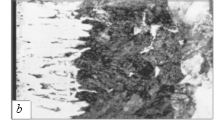Summary
The possibility of gas phase boronizing or boron vapor plating with a mixture of diborane and hydrogen has been established. The best results were obtained at 800–850°C (1470–1560°F) in 4–5 hours, with diborane/ hydrogen=1/75, flowing at 75–100 liters per hour. Under these conditions, a very hard boronized case, 200 microns (0.008 in) thick, was obtained on [carbon] steel 45; the surface microhardness was 3000.
Similar content being viewed by others
References
E. Weintraub, Journal Ind. Engg. Chem., 1911, (3).
A. W. Laubengauer, J. L. Hoard, and A. E. Newkirk, Journal Am. Chem. Soc., 1943, (65).
E. Eipeltauer, Gas Boronizing of Iron [and Steel]. Verlag Technik, Berlin, 1951.
G. R. Martin, U. S. Patent No. 2, 484, 519; Oct. 11, 1949.
N. Moss, National Research Council of Canada; Atomic Energy Project (NRC No. 1950); Chalk River, Ontario, 1947.
D. T. Hurd, Introduction to Chemistry of Hydrides (Translation into Russian), 1955.
Rights and permissions
About this article
Cite this article
Zhigach, A.F., Antonov, I.S., Pchelkina, M.A. et al. Surface impregnation of steel with boron from the gas phase. Met Sci Heat Treat 1, 47–50 (1959). https://doi.org/10.1007/BF00820275
Issue Date:
DOI: https://doi.org/10.1007/BF00820275



